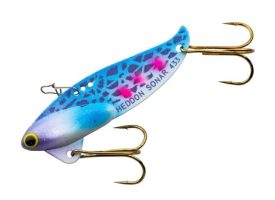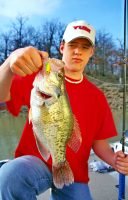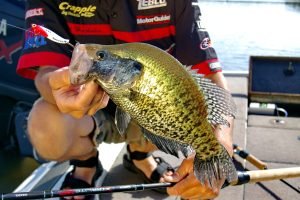The Reef Runner Cicada bladebait, like similar lures, creates a vibration
in the water that is irresistible to jumbo slabs like this. (Photo: Keith Sutton)
Big Bad Bladebaits
by Keith Sutton
For crappie anglers who typically use jigs or minnows to entice their quarry, bladebaits might seem like the misfits of the fishing-lure world. Often overlooked, these baits are, in fact, highly effective tools in the savvy angler’s arsenal, particularly under specific fishing conditions where their unique traits shine.
The Origin of Bladebaits
 The Heddon Sonar, which first hit the market around 1959, was the original bladebait to gain widespread popularity, followed shortly by Cotton Cordell’s Gay Blade. Both these lures feature a design that mimics a baitfish, with a metal-blade body sandwiched between lead pieces forming the “head.” The blade includes multiple line-tie holes on its top edge, while double hooks or treble hooks dangle from the bottom.
The Heddon Sonar, which first hit the market around 1959, was the original bladebait to gain widespread popularity, followed shortly by Cotton Cordell’s Gay Blade. Both these lures feature a design that mimics a baitfish, with a metal-blade body sandwiched between lead pieces forming the “head.” The blade includes multiple line-tie holes on its top edge, while double hooks or treble hooks dangle from the bottom.
Today’s bladebaits have evolved, with each manufacturer offering variations in shape, size and weight distribution that set their products apart. While the Sonar and Gay Blade feature sleek, straight bodies, others like Acme Tackle Company’s Reef Runner Cicada boast wider bodies with unique designs that create distinct actions in the water.
Color Variations
Originally, bladebaits were available only in a plain silver finish. Now, however, they come in a wide range of base colors like gold, copper and brass, with finishes that can be flat, hammered or rippled. Anglers also have the option of painted finishes, with some companies like Bass Pro Shops offering photorealistic designs that closely resemble live baitfish.
Targeting Deep Crappie with Bladebaits

Bladebaits excel in late winter and early spring when water temperatures are low and crappie are holding deep. A sharp upward snap of the rod tip sends the bait swimming through the water, generating a pulsating vibration that mimics an injured baitfish – an action that’s particularly effective in murky water.
You also can jig a bladebait vertically for a more subtle, fluttering motion that can entice hesitant crappie or retrieve it with varying speeds and pauses to create an erratic, attention-grabbing action that might wake up even the most sluggish slabs.
Bladebaits are particularly effective when targeting crappie along drop-offs and humps. To fish a drop-off, position your boat directly over the drop and cast toward the top, then work the lure back to the boat in small hops. When fishing humps, cast to the rise and work the bait over the top before letting it fall down the sides into deeper water. This method allows you to target crappie holding at different depths effectively.
Most strikes on bladebaits occur as the lure falls, so it’s essential to keep a close watch on your line and maintain tension throughout the retrieve. A slack line can mean missed opportunities, as crappie often strike while the bait is descending.
Customization for Maximum Effectiveness
One of the advantages of using bladebaits is the ability to customize them for different situations. Models feature two to five line-tie holes on the top edge, each providing a different action. Generally, the front hole offers a tighter, more subtle vibration, making it ideal for vertical jigging. If the bait has three holes, the middle one often provides a balanced action suitable for most situations.
Never tie your line directly to a bladebait; the sharp metal edges could easily cut through monofilament. Instead, use a round-bend snap or a split-ring to connect your line. This small adjustment can prevent costly break-offs and ensure that you stay connected to your catch.
To enhance the bait’s effectiveness, you can add noise by attaching stick-on eyes with rattling balls from a craft store. Some anglers also like to modify their bladebaits by adjusting the blade’s shape with pliers to create a concave or cupped profile, which alters the lure’s action and descent speed. Adding a touch of glitter nail polish can give dull baits a reflective finish that mimics the scales of small fish, making it even more enticing to crappie.
Bladebaits typically come with two treble hooks, but recent trends favor replacing one of the trebles with a double hook to reduce snags. On two-treble models, anglers often remove one of the hooks altogether, especially the forward treble, to minimize hang-ups.
Another modification involves biting the head off a soft-plastic twistertail grub, leaving just a couple of rings above the tail and adding it to the rear hook. This slows the bait’s descent and adds an extra pop of color. If the grub is scented, even better, as this can increase the lure’s effectiveness even more.
Sound and Scent Add Extra Attraction

In turbid waters, using a noisy bladebait like Heddon’s Rattling Sonar Flash can improve your chances of success. This lure features a steel ball in the eye chamber that creates sounds panfish quickly home in on, helping sight-hampered crappie locate your bait more easily.
Another technique involves adding a small minnow to the front or back hooks of the bladebait. This method is particularly popular among ice fishermen who use the Cordell Gay Blade for cold-water crappie. The added scent and natural movement of the minnow can make the bait irresistible to crappie, increasing your odds of landing more fish.
Why Bladebaits Deserve a Place in Your Tackle Box
While many crappie anglers stick stubbornly to jigs and minnows, those willing to experiment might find that bladebaits can be just as productive – if not more so – in the right conditions. When used correctly, these versatile lures can help you land slab crappie with ease. Whether you’re fishing deep water in winter or targeting spring crappie on drop-offs and humps, bladebaits offer a dynamic and effective alternative to more traditional baits.
Incorporating bladebaits into your crappie fishing strategy can be a game-changer. Their ability to mimic injured baitfish, combined with their customizable action and sound, make them a must-have for any serious crappie angler.
So next time you’re out on the water, don’t hesitate to tie on a bladebait—you might just be surprised by the results.
Keith Sutton is editor of our sister magazine at CatfishNOW.com. He’s been an avid crappie angler for more than half a century, pursuing his favorite panfish on waters throughout the United States. His fishing stories have been read by millions in hundreds of books, magazines, newspapers and Internet publications. In 2021, he was inducted into the Legends of the Outdoors Hall of Fame.


